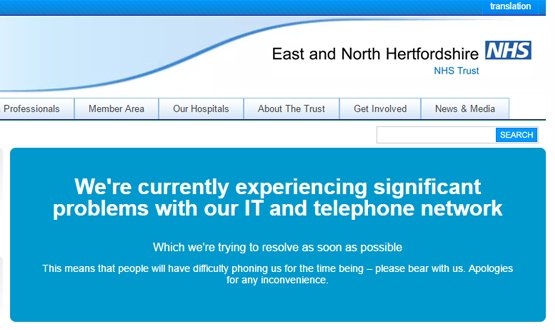WannaCry delays Lorenzo go-live at East and North Hertfordshire
- 28 July 2017

The impact of the May global cyber-attack has caused one trust to delay its Lorenzo electronic patient record (EPR) deployment for over two months.
East and North Hertfordshire NHS Trust has postponed its Lorenzo electronic patient record (EPR) go-live date from 1 July to 8 September, after “considerable disruption” from WannaCry.
The 12 May cyber-attack caused havoc around the world and in England dramatically impacting the NHS. A total of 48 trusts were infected by the ransomware which exploited a known Microsoft vulnerability.
East and North Hertfordshire declared a major incident, with a complete loss of IT systems and some telephony systems, according to its May board papers. Normal activity resumed on 19 May, and the trust said no patients were harmed as a result of the cyber-attack.
A trust spokesperson said that the cyber-attack “caused considerable disruption to the trust close to the original 1 July go-live date” and a decision was made to postpone the Lorenzo implementation.
DXC Technology’s Lorenzo is being deployed at East and North Hertfordshire as part of its Digital Transformation programme, as its EPR and also patient administration system (PAS).
The trust’s July board papers said that following a dress rehearsal for Lorenzo, concerns over three areas emerged: operational readiness, number of staff signed up for training and reporting word stream.
The 8 September go-live date “is still achievable provided all risks have been mitigated”, said the papers.
Digital Health News reported in July last year, that the trust was granted central funding to deploy Lorenzo as its EPR, as part of the deal agreed between the Department of Health and CSC in 2012.
East and North Hertfordshire confirmed at the time it would receive £3.09 million over two years, as part of the deal.
CSC changed its name to DXC Technology in April following a merger with Hewlett-Packard Enterprise.
As part of the trust’s digital initiative, electronic observation software, Nervecentre, is also being rolled out for clinical and nursing patient observations, escalation and emergency department systems.
The cyber-attack did not affect the Nervecentre roll-out.
“Significant progress has been made in the incremental roll out of the Nervecentre electronic observations and the new pharmacy system has been successfully implemented”, said the July papers.
North Staffordshire Combined Healthcare NHS Trust also pushed back its Lorenzo deployment plans following the cyber-attack. The trust delayed its go-live by a week after its shut down its IT systems as a precaution.
East and North Hertfordshire provide care for about 500,000 people annually, and operate from four different sites.





3 Comments
15 years ago this product was promised under the granger era of NHS IT ; yet there are still people in charge of digital solutions clinging to the hope this will deliver! The world has move on, smarter digital devices that provide real value to patients and bring about major improvements have surpassed the need for antiquated PAS/EPR. The majority of acute doctors create and read digital letters accounts for 80% access, request and view test results 12% and the need for better ‘social media’ secure technology to share key information to keep their patients safe at handover, meds and results reconciliation and discharge. These old systems were designed in the 90’s built in the 00’s and deployed too far too late to be effective !! Our systems are as dated as the people who lead on their deployment and procurement. Let’s wake up and get these smart companies develop the systems we need for 2020! If Lorenzo is that let’s hear it from the rooftops and welcome it !!
Agree. Do you have links for those figures, they would be very useful when I need to convince people to ‘walk rather than run’
Ronnie, you are spot on. Let’s have systems designed at least in the 0s and delivered in the 1s
Comments are closed.